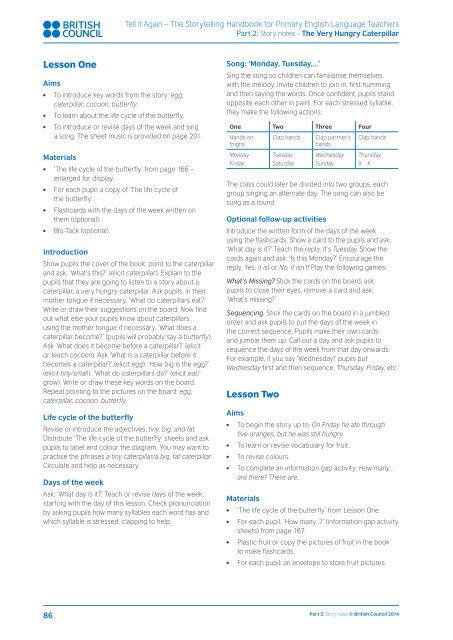1nW0gvB
1nW0gvB
1nW0gvB
You also want an ePaper? Increase the reach of your titles
YUMPU automatically turns print PDFs into web optimized ePapers that Google loves.
Tell it Again – The Storytelling Handbook for Primary English Language Teachers<br />
Part 2: Story notes – The Very Hungry Caterpillar<br />
Lesson One<br />
Aims<br />
●●<br />
●●<br />
●●<br />
To introduce key words from the story: egg,<br />
caterpillar, cocoon, butterfly.<br />
To learn about the life cycle of the butterfly.<br />
To introduce or revise days of the week and sing<br />
a song. The sheet music is provided on page 201.<br />
Materials<br />
● ● ‘The life cycle of the butterfly’ from page 166 –<br />
enlarged for display.<br />
●●<br />
●●<br />
●●<br />
For each pupil: a copy of ‘The life cycle of<br />
the butterfly’.<br />
Flashcards with the days of the week written on<br />
them (optional).<br />
Blu-Tack (optional).<br />
Introduction<br />
Show pupils the cover of the book, point to the caterpillar<br />
and ask, ‘What’s this?’ (elicit caterpillar). Explain to the<br />
pupils that they are going to listen to a story about a<br />
caterpillar, a very hungry caterpillar. Ask pupils, in their<br />
mother tongue if necessary, ‘What do caterpillars eat?’<br />
Write or draw their suggestions on the board. Now find<br />
out what else your pupils know about caterpillars,<br />
using the mother tongue if necessary. ‘What does a<br />
caterpillar become?’ (pupils will probably say a butterfly).<br />
Ask ‘What does it become before a caterpillar?’ (elicit<br />
or teach cocoon). Ask ‘What is a caterpillar before it<br />
becomes a caterpillar?’ (elicit egg). ‘How big is the egg?’<br />
(elicit tiny/small). ‘What do caterpillars do?’ (elicit eat/<br />
grow). Write or draw these key words on the board.<br />
Repeat pointing to the pictures on the board: egg,<br />
caterpillar, cocoon, butterfly.<br />
Life cycle of the butterfly<br />
Revise or introduce the adjectives, tiny, big, and fat.<br />
Distribute ‘The life cycle of the butterfly’ sheets and ask<br />
pupils to label and colour the diagram. You may want to<br />
practise the phrases a tiny caterpillar/a big, fat caterpillar.<br />
Circulate and help as necessary.<br />
Days of the week<br />
Ask: ‘What day is it?’ Teach or revise days of the week,<br />
starting with the day of this lesson. Check pronunciation<br />
by asking pupils how many syllables each word has and<br />
which syllable is stressed, clapping to help.<br />
Song: ‘Monday, Tuesday,…’<br />
Sing the song so children can familiarise themselves<br />
with the melody. Invite children to join in, first humming<br />
and then saying the words. Once confident, pupils stand<br />
opposite each other in pairs. For each stressed syllable,<br />
they make the following actions:<br />
One Two Three Four<br />
Hands on<br />
thighs<br />
Monday<br />
Friday<br />
Clap hands<br />
Tuesday<br />
Saturday<br />
Clap partner’s<br />
hands<br />
Wednesday<br />
Sunday<br />
Clap hands<br />
Thursday<br />
X X<br />
The class could later be divided into two groups, each<br />
group singing an alternate day. The song can also be<br />
sung as a round.<br />
Optional follow-up activities<br />
Introduce the written form of the days of the week<br />
using the flashcards. Show a card to the pupils and ask:<br />
‘What day is it?’ Teach the reply, It’s Tuesday. Show the<br />
cards again and ask: ‘Is this Monday?’ Encourage the<br />
reply, Yes, it is! or No, it isn’t! Play the following games:<br />
What’s Missing? Stick the cards on the board, ask<br />
pupils to close their eyes, remove a card and ask:<br />
‘What’s missing?’<br />
Sequencing. Stick the cards on the board in a jumbled<br />
order and ask pupils to put the days of the week in<br />
the correct sequence. Pupils make their own cards<br />
and jumble them up. Call out a day and ask pupils to<br />
sequence the days of the week from that day onwards.<br />
For example, if you say ‘Wednesday!’ pupils put<br />
Wednesday first and then sequence, Thursday, Friday, etc.<br />
Lesson Two<br />
Aims<br />
●●<br />
●●<br />
●●<br />
●●<br />
To begin the story up to: On Friday he ate through<br />
five oranges, but he was still hungry.<br />
To learn or revise vocabulary for fruit.<br />
To revise colours.<br />
To complete an information gap activity: How many…<br />
are there? There are…<br />
Materials<br />
● ● ‘The life cycle of the butterfly’ from Lesson One.<br />
●●<br />
●●<br />
●●<br />
For each pupil: ‘How many…?’ (information gap activity<br />
sheets) from page 167.<br />
Plastic fruit or copy the pictures of fruit in the book<br />
to make flashcards.<br />
For each pupil: an envelope to store fruit pictures.<br />
86<br />
Part 2: Story notes © British Council 2014


